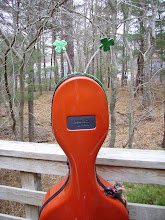
Alas, it is the same book, just in bass clef. I tried playing a few pieces and was surprised and delighted to find them quite easy to play. Suddenly it dawned on me: the tunes had been transposed to cello-friendly keys. Yes, they are easy to play, but you can't play them with a fiddle group. Every single one of the pieces had one sharp fewer than the fiddle book.
Then I had another realization: If I pretended they were written in tenor clef, rather than in bass clef (and added a sharp), all would be well, and I'd have lots of practice reading tenor clef. (Until I memorize the pieces, of course.)
That or return the book. I haven't decided, but am leaning toward keeping it. And writing to Latham Music about how they might make this book more useful for the fiddling cellist.
Anyway, I'd recommend the book (which comes with a CD) to anyone who wants to get the feeling of playing fiddle tunes without shifting too much (or buying a five-string cello), but is not playing with a fiddle group. Or for someone who is playing with instrumentalists willing and able to play in cello-friendly keys. The CD, by the way, features a viola, not a cello, and the fast versions ot the tunes are really, really fast. Too fast for me.
Another fiddle-related option for learning clefs: Rick Mooney's Thumb Position for Cello Book 1 contains a number of fiddle tunes too, in duet form, in treble clef with the accompaniment part in bass clef.












5 comments:
I bought the cello version of Fiddling for Classical Stiffs because I really liked the title and because yes, I am a Classical Stiff! When I was in Ireland about a month ago (it seems so much longer ago) I bought 2 fiddle books there which were in treble clef, and have just been playing the pieces one octave lower. Is that what you have been doing when playing the cello?
Hi CelloGeek,
Yes, I sometimes read the treble clef and play an octave lower, but I also collect fiddle music written for cello, as well as transcribe music for cello.
I play with a fiddle group that has their own versions of many tunes (unwritten--most play by ear), so I need to learn the tune more or less the way my fiddle group plays it. I often end up re-writing it for cello (as they play it) in Coda Finale and printing it out to learn/memorize it. We have a huge repertoire, so I'm always looking for fiddle tune books (to avoid learning by ear). The fiddle books written for cello make the process easier (especially if some thought has been put into the arrangements) and give me more options, as the printed versions of a tune varies a lot.
I sometimes change the octave in order to make it easier to play quickly without jumping around too much (go two octaves lower, for instance). Or I simplify the tune. The fiddlers in my group play very fast and don't use sheet music, so it is usually better for me to write out a simpler version of the tune, reducing the 8th notes to quarter notes, for instance, that I then memorize. (Or play accompaniment, which I improvise.)
I know this would all be easier if I could play by ear, but I am doing it this awkward, round-about way because I am a classical stiff too. :-) I am going to a "learn-by-ear" fiddle camp on Saturday, though, so I may soon see the light.
Then there is a whole other class of fiddle music (particularly Celtic) that I play for myself, for fun, or to work on cello issues, when I am not racing to keep up with the fiddlers. Then I don't care what key it is in or what clef it is in. But, another time. This comment is already much too long!
CelloGeek, This morning, it occurred to me that you might have been asking a much simpler question: why not just use the treble version of this particular book? Good point; that would also work. :-)
I appreciate the detailed answer and it was really interesting to read about how you play with your fiddle group. One of the books I bought in Ireland has over 1000 tunes in it - more of a reference, I guess, but I couldn't resist it.
Hi CelloGeek, You must have one of the O'Neill collections of fiddle tunes. There is a 1,000-tune book and an 1,850-tune book. Either ought to keep anyone busy! I haven't bought either...yet.
Post a Comment